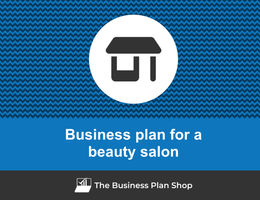How to create a financial forecast for a beauty salon?
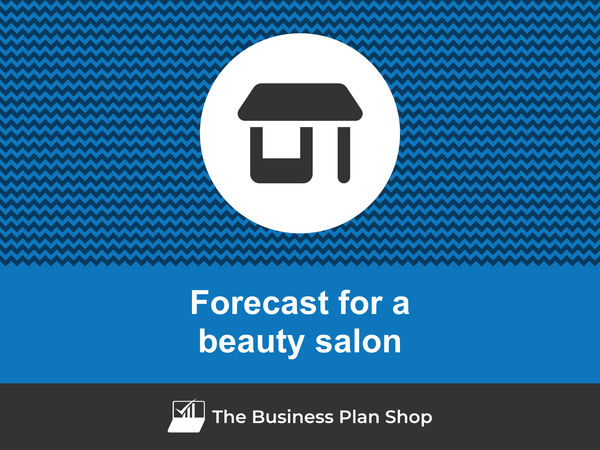
If you are serious about keeping visibility on your future cash flows, then you need to build and maintain a financial forecast for your beauty salon.
Putting together a beauty salon financial forecast may sound complex, but don’t worry, with the right tool, it’s easier than it looks, and The Business Plan Shop is here to guide you.
In this practical guide, we'll cover everything you need to know about building financial projections for your beauty salon.
We will start by looking at why they are key, what information is needed, what a forecast looks like once completed, and what solutions you can use to create yours.
Let's dive in!
Why create and maintain a financial forecast for a beauty salon?
In order to prosper, your business needs to have visibility on what lies ahead and the right financial resources to grow. This is where having a financial forecast for your beauty salon becomes handy.
Creating a beauty salon financial forecast forces you to take stock of where your business stands and where you want it to go.
Once you have clarity on the destination, you will need to draw up a plan to get there and assess what it means in terms of future profitability and cash flows for your beauty salon.
Having this clear plan in place will give you the confidence needed to move forward with your business’s development.
Having an up-to-date financial forecast for a beauty salon is also useful if your trading environment worsens, as the forecast enables you to adjust to your new market conditions and anticipate any potential cash shortfall.
Finally, your beauty salon's financial projections will also help you secure financing, as banks and investors alike will want to see accurate projections before agreeing to finance your business.
Need a solid financial forecast?
The Business Plan Shop does the maths for you. Simply enter your revenues, costs and investments. Click save and our online tool builds a three-way forecast for you instantly.

What information is used as input to build a beauty salon financial forecast?
A beauty salon's financial forecast needs to be built on the right foundation: your assumptions.
The data required to create your assumptions will depend on whether you are a new or existing beauty salon.
If you are creating (or updating) the forecast of an existing beauty salon, then your main inputs will be historical accounting data and operating metrics, and your team’s view on what to expect for the next three to five years.
If you are building financial projections for a new beauty salon startup, you will need to rely on market research to form your go-to-market strategy and derive your sales forecast.
For a new venture, you will also need an itemised list of resources needed for the beauty salon to operate, along with a list of equipment required to launch the venture (more on that below).
Now that you understand what is needed, let’s have a look at what elements will make up your beauty salon's financial forecast.
The sales forecast for a beauty salon
From experience, it is usually best to start creating your beauty salon financial forecast by your sales forecast.
To create an accurate sales forecast for your beauty salon, you will have to rely on the data collected in your market research, or if you're running an existing beauty salon, the historical data of the business, to estimate two key variables:
- The average price
- The number of monthly transactions
To get there, you will need to consider the following factors:
- The introduction of new beauty treatments and services, such as lash extensions or microblading, can potentially increase the average price of services and attract more customers to your salon.
- Changes in fashion and beauty trends can also affect the average price of services, as certain treatments or styles may become more popular and in demand.
- The opening of a new competitor salon in the area may result in a decrease in the number of monthly transactions, as customers may choose to try out the new salon instead of returning to yours.
- The economic climate can also impact the average price of services, as customers may have less disposable income during a recession or may be more willing to splurge during a period of economic growth.
- The seasonality of certain beauty treatments, such as spray tans or holiday-themed nail designs, may affect the average price and number of monthly transactions, with peak seasons bringing in more business and off-seasons resulting in a decline in sales.
Once you have an idea of what your future sales will look like, it will be time to work on your overhead budget. Let’s see what this entails.
Need inspiration for your business plan?
The Business Plan Shop has dozens of business plan templates that you can use to get a clear idea of what a complete business plan looks like.

The operating expenses for a beauty salon
Once you know what level of sales you can expect, you can start budgeting the expenses required to operate your beauty salon on a daily basis.
Expenses normally vary based on how much revenue you anticipate (which is why, from experience, it is always better to start your forecast with the topline projection), and where your business is based.
Operating expenses for a beauty salon will include some of the following items:
- Staff wages and benefits: This includes salaries, bonuses, and benefits for all staff members, including hairstylists, nail technicians, receptionists, and other support staff.
- Rent or lease: This expense covers the cost of renting or leasing your salon space.
- Utilities: This includes electricity, water, and gas bills for your salon.
- Supplies and inventory: This expense covers the cost of purchasing beauty products, equipment, and supplies for your salon, such as hair dye, nail polish, and towels.
- Marketing and advertising: This includes expenses for promoting your salon, such as creating flyers, running social media ads, and participating in local events.
- Insurance: You will need to have insurance to protect your salon from any potential liabilities or accidents.
- Accountancy fees: You may need to hire an accountant to help you with bookkeeping, tax preparation, and other financial tasks.
- Software licenses: If you use salon management software or other digital tools, you will need to pay for their licenses or subscriptions.
- Banking fees: This includes fees for using credit card processing services, ATM fees, and other bank-related charges.
- Cleaning and maintenance: You will need to keep your salon clean and well-maintained, which may require hiring cleaning services or purchasing cleaning supplies.
- Professional development: It's important to continue learning and improving your skills as a beauty professional, so you may need to budget for training courses and workshops.
- Licenses and permits: You will need to obtain the necessary licenses and permits to legally operate your salon.
- Taxes: You will need to pay income taxes, property taxes, and other taxes related to your salon business.
- Uniforms and other work-related attire: Your staff may need uniforms or other clothing to wear while working in the salon.
- Professional memberships: Joining professional organizations can provide networking opportunities and access to resources, but may also come with membership fees.
This list will need to be tailored to the specificities of your beauty salon, but should offer a good starting point for your budget.
What investments are needed to start or grow a beauty salon?
Once you have an idea of how much sales you could achieve and what it will cost to run your beauty salon, it is time to look into the equipment required to launch or expand the activity.
For a beauty salon, capital expenditures and initial working capital items could include:
- Salon Equipment: This includes items such as styling chairs, shampoo bowls, hair dryers, and manicure/pedicure stations. These are essential fixed assets for a beauty salon and can be a significant investment.
- Furniture and Decor: In addition to salon equipment, you will also need to invest in furniture and decor to create a welcoming and comfortable atmosphere for your clients. This may include items such as reception desks, waiting area chairs, and decorative elements like artwork and lighting.
- Building Renovations: If you are starting a new salon or moving to a new location, you may need to make renovations or improvements to the building to meet your specific needs. This could include installing plumbing for shampoo bowls, building walls for private treatment rooms, or updating the flooring and paint.
- Computer Systems and Software: A modern beauty salon will likely need a computer system to manage appointments, inventory, and other aspects of the business. This may also include specialized beauty salon software for things like online booking and client management.
- Retail Products: While not technically a fixed asset, retail products can be a significant expense for a beauty salon. These are products that are sold to clients, such as hair care products, cosmetics, and accessories. It is important to carefully budget for these items as they can have a big impact on your overall revenue.
Again, this list will need to be adjusted according to the specificities of your beauty salon.
Need a convincing business plan?
The Business Plan Shop makes it easy to create a financial forecast to assess the potential profitability of your projects, and write a business plan that’ll wow investors.

The financing plan of your beauty salon
The next step in the creation of your financial forecast for your beauty salon is to think about how you might finance your business.
You will have to assess how much capital will come from shareholders (equity) and how much can be secured through banks.
Bank loans will have to be modelled so that you can separate the interest expenses from the repayments of principal, and include all this data in your forecast.
Issuing share capital and obtaining a bank loan are two of the most common ways that entrepreneurs finance their businesses.
What tables compose the financial plan for a beauty salon?
Now let's have a look at the main output tables of your beauty salon's financial forecast.
The profit & loss forecast
The forecasted profit & loss statement will enable you to visualise your beauty salon's expected growth and profitability over the next three to five years.
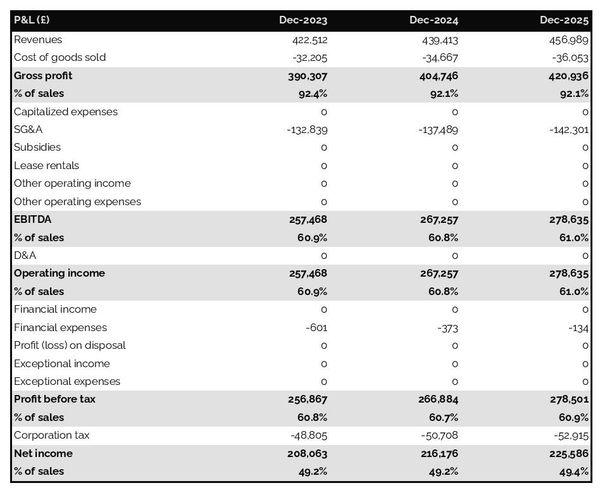
A financially viable P&L statement for a beauty salon should normally show:
- Sales growing above inflation
- Stable or expanding (ideally) profit margins
- A net profit
This will of course depend on the stage of your business: a new venture might be loss-making until it reaches its breakeven point in year 2 or 3, for example.
The projected balance sheet
The projected balance sheet gives an overview of your beauty salon's financial structure at the end of the financial year.
It is composed of three categories of items: assets, liabilities and equity:
- Assets: are what the business possesses and uses to produce cash flows. It includes resources such as cash, buildings, equipment, and accounts receivable (money owed by clients).
- Liabilities: are the debts of your beauty salon. They include accounts payable (money owed to suppliers), taxes due and bank loans.
- Equity: is the combination of what has been invested by the business owners and the cumulative profits to date (which are called retained earnings). Equity is a proxy for the value of the owner's stake in the business.
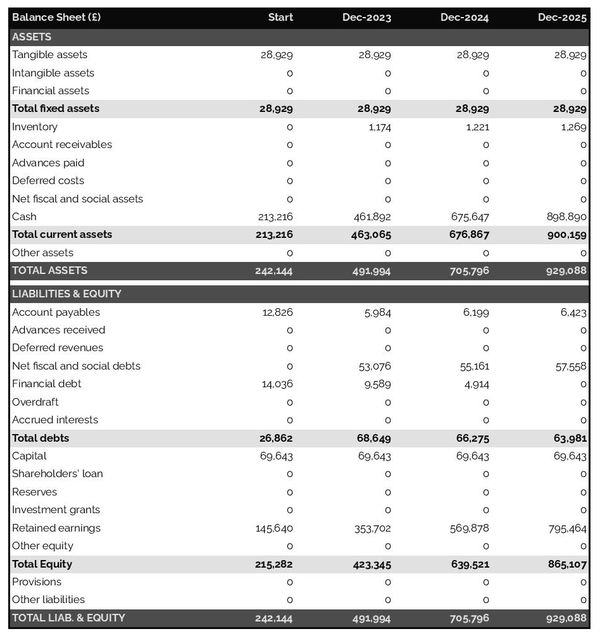
The projected cash flow statement
A projected cash flow statement for a beauty salon is used to show how much cash the business is generating or consuming.
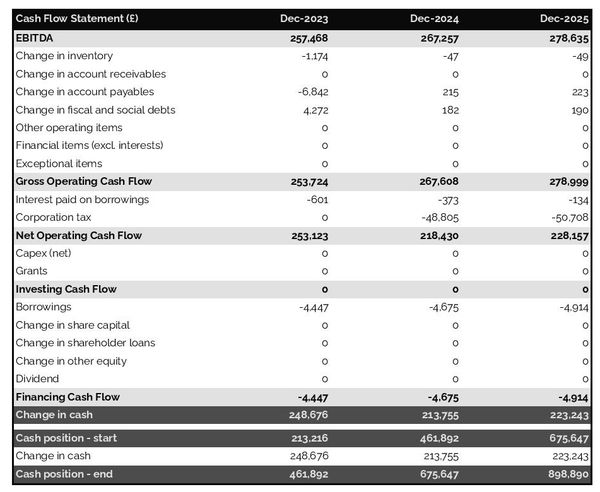
The cash flow forecast is usually organised by nature to show three key metrics:
- The operating cash flow: do the core business activities generate or consume cash?
- The investing cash flow: how much is the business investing in long-term assets (this is usually compared to the level of fixed assets on the balance sheet to assess whether the business is regularly maintaining and renewing its equipment)?
- The financing cash flow: is the business raising new financing or repaying financiers (debt repayment, dividends)?
Cash is king and keeping an eye on future cash flows is imperative for running a successful business. Therefore, you should pay close attention to your beauty salon's cash flow forecast.
If you are trying to secure financing, note that it is customary to provide both yearly and monthly cash flow forecasts in a financial plan - so that the reader can analyze seasonal variation and ensure the beauty salon is appropriately capitalised.
Need a solid financial forecast?
The Business Plan Shop does the maths for you. Simply enter your revenues, costs and investments. Click save and our online tool builds a three-way forecast for you instantly.

Which tool should you use to create your beauty salon's financial projections?
Building a beauty salon financial forecast is not difficult provided that you use the right tool for the job. Let’s see what options are available below.
Using online financial forecasting software to build your beauty salon's projections
The modern and easiest way is to use professional online financial forecasting software such as the one we offer at The Business Plan Shop.
There are several advantages to using specialised software:
- You can easily create your financial forecast by letting the software take care of the financial calculations for you without errors
- You have access to complete financial forecast templates
- You get a complete financial forecast ready to be sent to your bank or investors
- You can easily track your actual financial performance against your financial forecast, and recalibrate your forecast as the year goes by
- You can create scenarios to stress test your forecast's main assumptions
- You can easily update your forecast as time goes by to maintain visibility on future cash flows
- You have a friendly support team on standby to assist you when you are stuck
- It’s cost-efficient and much cheaper than using an accountant or consultant (see below)
If you are interested in this type of solution, you can try our forecasting software for free by signing up here.
Calling in a financial consultant or chartered accountant
Enlisting the help of a consultant or accountant is also a good way to obtain a professional beauty salon financial forecast.
The downside of this solution is its cost. From experience, obtaining a simple financial forecast over three years (including a balance sheet, income statement, and cash flow statement) is likely to cost a minimum of £700 or $1,000.
The indicative cost above, is for a small business, and a forecast is done as a one-shot exercise. Using a consultant or accountant to track your actuals vs. forecast and to keep your financial projections up to date on a monthly or quarterly basis will cost a lot more.
If you opt for this solution, make sure your accountant has in-depth knowledge of your industry, so that they may challenge your figures and offer insights (as opposed to just taking your assumptions at face value to create the forecast).
Why not use a spreadsheet such as Excel or Google Sheets to build your beauty salon's financial forecast?
Creating an accurate and error-free beauty salon financial forecast with a spreadsheet is very technical and requires a deep knowledge of accounting and an understanding of financial modelling.
Very few business owners are financially savvy enough to be able to build a forecast themselves on Excel without making mistakes.
Lenders and investors know this, which is why forecasts created on Excel by the business owner are often frowned upon.
Having numbers one can trust is key when it comes to financial forecasting and to that end using software is much safer.
Using financial forecasting software is also faster than using a spreadsheet, and, with the rise of artificial intelligence, software is also becoming smarter at helping us analyse the numbers to make smarter decisions.
Finally, like everything with spreadsheets, tracking actuals vs. forecasts and keeping your projections up to date as the year progresses is manual, tedious, and error-prone. Whereas financial projection software like The Business Plan Shop is built for this.
Need a convincing business plan?
The Business Plan Shop makes it easy to create a financial forecast to assess the potential profitability of your projects, and write a business plan that’ll wow investors.

Use our financial forecast templates for inspiration
The Business Plan Shop has dozens of financial forecast examples available.
Our templates contain both a financial forecast and a written business plan which presents, in detail, the company, the team, the strategy, and the medium-term objectives.
Our templates are a great source of inspiration, whether you just want to see what a complete business plan looks like, or are looking for concrete examples of how you should model financial elements in your own forecast.
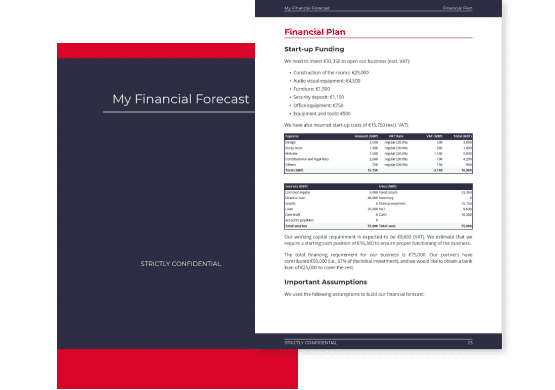
Takeaways
- Having a financial forecast enables you to visualise the expected growth, profitability, and cash generation for your business over the next three to five years.
- Tracking actuals vs. forecast and keeping your financial projections up-to-date is the only way to get a view on what your beauty salon future cash flows may look like.
- Using financial forecasting software is the mordern and easy way to create and maintain your forecasts.
This is the end of our guide on how to build the financial forecast for a beauty salon, we hope you found it useful. Don't hesitate to contact us if you want to share your feedback or have any questions.
Need inspiration for your business plan?
The Business Plan Shop has dozens of business plan templates that you can use to get a clear idea of what a complete business plan looks like.

Also on The Business Plan Shop
Know someone who owns or is thinking of starting a beauty salon? Share our forecasting guide with them!



